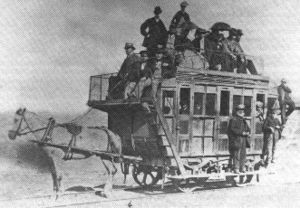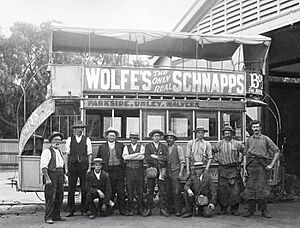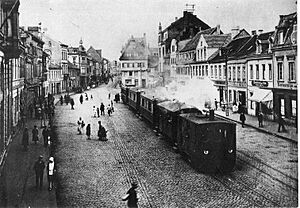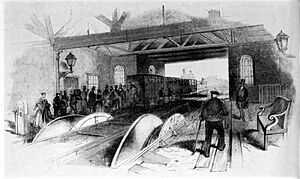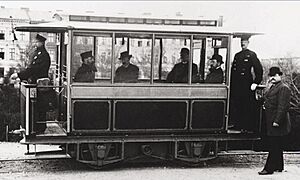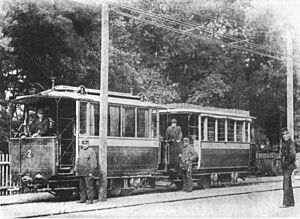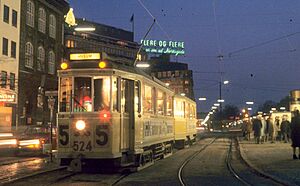History of trams facts for kids
Trams, also known as streetcars or trolleys, are a type of train that runs on tracks, usually right on city streets. They have a long and interesting history, starting way back in the early 1800s. Over time, trams have used many different ways to move, like horses, steam, cables, and electricity. This article will explore how these cool vehicles have changed throughout history!
Contents
Trams Pulled by Animals


The very first tram for passengers started in 1807 in Swansea, Wales, UK. It was called the Swansea and Mumbles Railway. These early trams were pulled by horses, and sometimes even mules!
In 1860, Birkenhead in Europe became the first town to have a street tramway. An American named George Francis Train started it. In America, the first streetcar began in New York City in 1832, designed by John Stephenson. New Orleans, Louisiana, has the oldest continuously running street railway system in the world, starting in 1835.
Horse-drawn trams also appeared in other parts of the world:
- France (1839)
- Santiago, Chile (1858)
- Sydney, Australia (1860)
- Alexandria, Africa (1863)
- Batavia (now Jakarta), Asia (1869)
Why Horses Were Replaced
Using horses had many problems. Horses could only work for a few hours a day. They needed homes, food, and lots of care. Plus, they produced a lot of manure, which the tram companies had to clean up and get rid of! A typical horse pulled a tram for about 12 miles a day. Many tram systems needed ten or more horses for each tram car.
Because of these issues, electric trams started to replace horse-drawn ones in the late 1800s. Inventors like Werner von Siemens in Germany and Frank J. Sprague in the USA developed new electric systems. Sprague's "trolley pole" system, which collected electricity from overhead wires, was very successful in Richmond, Virginia, in 1888. This made electric trams much cheaper to run than horse trams.
Some horse-drawn trams lasted a long time. New York City had horse trams until 1917. Pittsburgh had them until 1923. The last regular mule-drawn trams in the US ran until 1926 in Sulphur Rock, Arkansas. In Mexico, mule trams ran until 1954! The very last horse-drawn tram in the UK stopped in 1957 in Northern Ireland.
Today, you can still ride horse-drawn trams in a few places, like the Douglas Bay Horse Tramway on the Isle of Man and the Victor Harbor Horse Drawn Tram in Adelaide, South Australia. There are also new ones at the Hokkaidō Museum in Japan and in Disneyland.
Steam-Powered Trams
After horses, the first mechanical trams were powered by steam. There were two main types:
- Small steam locomotives: These were like tiny trains, with a separate steam engine pulling one or more carriages. You could find these in places like Christchurch, New Zealand; Adelaide, Australia; and Munich, Germany.
- Steam engines inside the tram: These trams had the engine built right into the tram's body. Paris used this style a lot.
Steam trams had special designs to make them safe for city streets. Their wheels and moving parts were covered to prevent accidents and reduce noise. They also tried to avoid making visible smoke or steam. They often burned coke instead of coal to reduce smoke.
However, steam trams had a big problem: their engines were often not powerful enough because there wasn't much space for them. By the early 1900s, electric trams had mostly replaced steam trams.
Cable-Hauled Trams
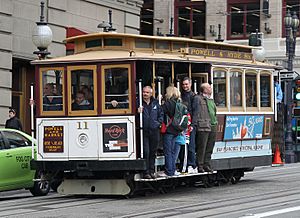
Another way to power trams was with a moving steel cable. The cable ran underground, and the tram would "grip" onto it to be pulled along the tracks. The power for the cable came from a special "powerhouse" building, usually far away.
The first practical cable car line was tested in San Francisco in 1873. Its success was partly due to a clever invention: a reliable "cable grip" that could grab and release the moving cable without damaging it. The second city to use cable trams was Dunedin in New Zealand, from 1881 to 1957.
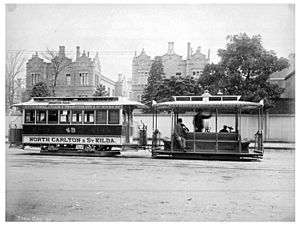

From 1885 to 1940, Melbourne, Australia, had one of the largest cable tram systems in the world. At its busiest, it had 592 trams running on 75 kilometers (47 miles) of track.
Why Cable Trams Were Replaced
Cable cars were very expensive to build. They needed a complex system of cables, pulleys, engines, and long underground tunnels. They also required strong and skilled operators to manage the grip and release of the cable, especially when crossing other lines. If the cable broke, the whole line would stop until it was fixed. Because of these high costs and maintenance, cable cars were quickly replaced by electric trams once they became reliable.
However, cable cars were great for hilly cities because their wheels wouldn't slip on steep slopes. The moving cable would pull the car steadily uphill. This is why cable cars still survive in San Francisco, where they are a famous tourist attraction and still used for transport. A cable line also runs in Wellington, New Zealand, and up the Great Orme hill in North Wales, UK.
Gas-Powered Trams
In the late 1800s and early 1900s, some places tried using trams powered by gas, like naphtha gas or coal gas. These trams operated in places like Melbourne, Australia; Berlin and Dresden, Germany; and in the UK.
Not much is known about gas trams, as they were not very common. In 2015, China even showed off a tram powered by hydrogen fuel cells, which is a very modern idea!
Electric Trams: The Big Change
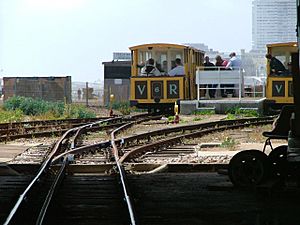

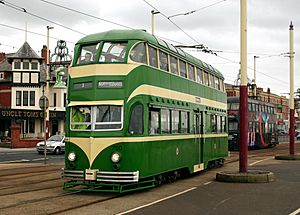
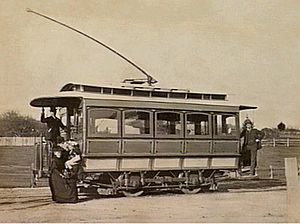
The first experimental electric tramway was built in Russia in 1875. The first successful commercial electric tram line opened in Lichterfelde, near Berlin, Germany, in 1881. It was built by Werner von Siemens.
In Britain, the Volk's Electric Railway opened in Brighton in 1883. This line is still running today and is the oldest operating electric tramway in the world! Also in 1883, the Mödling and Hinterbrühl Tram opened near Vienna, Austria. It was the first tram in regular service to get electricity from an overhead line using a pantograph (a device that collects power from the wire). The Blackpool Tramway in England opened in 1885 and is also still running today in a modern form.
In the US, the first commercial electric streetcar opened in Cleveland, Ohio, in 1884. Frank J. Sprague built a successful electric tram system in Richmond, Virginia, in 1888. Sprague also invented "multiple unit control" in 1897. This allowed several tram cars to be linked together and controlled by just one driver, which led to modern subway trains.
With new and reliable technology, electric tram systems quickly spread around the world.
- Sarajevo built an electric tram system in 1885.
- Budapest started its tramway system in 1887. Its main line is now the busiest in Europe, with a tram every 60 seconds during busy times!
- Bucharest and Belgrade started regular service in 1894.
- Ljubljana introduced its tram system in 1901.
Australia also adopted electric trams quickly. The first electric tramway was shown in Melbourne in 1888. By the 1970s, most tram systems in Australia had closed, except for Melbourne's, which is one of the largest in the world and has been modernized and expanded.
In Japan, the Kyoto Electric railroad was the first tram system, starting in 1895. By 1932, Japan had 82 tram companies in 65 cities!
Safety with Electric Trams
One safety issue with early electric trams was if they lost contact with the rails (for example, if they derailed or stopped on a very sandy part of the track). If this happened, the tram's metal frame could become electrically charged, usually at 600 volts! Anyone stepping off the tram could get a nasty electric shock. Drivers had to be careful to jump off without touching the tram and the ground at the same time, then pull down the power collector before letting passengers off.
Today, new technologies are making trams even better. Some trams don't need overhead wires; they get power from a third rail or from special plates embedded in the track.
Other Ways Trams Were Powered
Some places used other power sources:
- Petrol (gasoline) trams: Used in places like Hastings in the UK and Stockholm, Sweden.
- Compressed air trams: Paris used trams powered by compressed air.
- Diesel trams: The Galveston Island Trolley in Texas used diesel trams because hurricanes could easily damage electrical systems.
- Hidden diesel motors: The tourist tram in Portland, Victoria, Australia, looks like a cable car but actually uses a hidden diesel engine.
Hybrid Tram Systems

A "hybrid" system combines different power types. The Trieste–Opicina tramway in Trieste, Italy, is a great example. Most of the way, it's a normal electric tram. But on one very steep part of the track, special cable tractors push the trams uphill and act as brakes when going downhill. This makes sure the trams can handle the steep slope safely.
Tram Tracks and Design
At first, tram rails stuck up above the street, which could cause accidents for people. But in 1852, Alphonse Loubat invented "grooved rails" or "girder rails." These rails were designed to be level with the street, making them much safer. Loubat built the first tram line in Paris, France, using these new rails in 1853.
The Toronto streetcar system in Canada is one of the few in North America that still runs like classic trams. They share the road with cars and stop frequently like buses, rather than having fixed stations. These trams, known as "Red Rockets" because of their color, have been running since 1856 (horse-drawn) and 1892 (electric).
The Decline of Trams
By the 1950s, trams started to disappear from most Western and Asian countries. Why?
- Cars and buses: More people bought cars, and buses became much better. Buses didn't need expensive tracks to be built, making them seem cheaper and more flexible.
- Roads over rails: Governments started investing more money in building roads and highways for cars, seeing them as a sign of progress.
- Lack of maintenance: Tram networks were often not kept up or modernized, making them seem old and slow compared to new buses.
Many cities, like Manchester in the UK, completely removed their tram systems. In the US, there were even claims that bus and oil companies purposely tried to replace trams with buses. The oldest tram system, the Swansea and Mumbles Railway, was bought by a bus company and closed in 1960.
Tram networks almost completely disappeared from France, the UK, Ireland, Denmark, and Spain. Cities like Sydney, which once had one of the largest tram networks in the world, removed all their tracks. Most tram networks also disappeared in North America.
However, some cities kept their trams, like Boston, Philadelphia, San Francisco, and New Orleans in the US, and Toronto in Canada. Trams were also generally kept or modernized in most communist countries, as well as Switzerland, Germany, Austria, Belgium, Norway, Portugal, Sweden, and Japan. In Great Britain, only the Blackpool Tramway kept running.
The Return of Trams

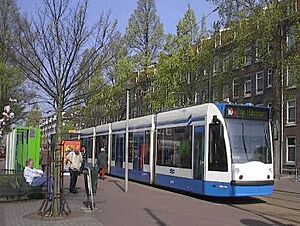
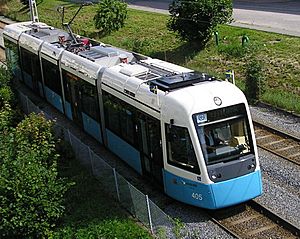
By the late 1970s, people started to realize that focusing only on cars caused problems like smog, traffic congestion, and noise. Building underground subway systems (rapid transit) was very expensive and difficult in some cities.
Suddenly, the advantages of trams became clear again! They were cheaper to build than subways and could help reduce pollution and traffic.
Trams in the 1980s and 1990s
- Germany: The Stadtbahnwagen B was a modern tram-train hybrid that could run on both tram and heavy rail tracks.
- North America: The Canadian city of Edmonton brought back modern trams in 1978, followed by Calgary and San Diego.
- Britain: The UK started replacing old railways with light rail systems, like the Tyne & Wear Metro (1980) and the Docklands Light Railway in London. The success of the Manchester Metrolink (1992) and Sheffield Supertram (1992) really established the trend.
- France: Nantes and Grenoble opened new modern tram systems in 1985 and 1988. Strasbourg opened a system in 1994 with cool new trams designed to make them seem modern and exciting.
- Munich: This city had almost replaced its trams with a subway, but citizens protested. So, Munich bought new trams and modernized its system.
- Berlin: East Berlin kept its tram network and even extended new lines into West Berlin after Germany was reunified.
Trams in the 21st Century
- Athens: Trams returned to Athens for the 2004 Summer Olympics, connecting with the subway and buses.
- Melbourne: The already large tram system in Melbourne continues to grow with new extensions.
- Sydney: Trams returned to Sydney in 1997 as "light rail" and have been extended since.
- Prague: In 2009, Prague introduced the Škoda 15 T, the world's first completely low-floor tram with special flexible parts.
- Edinburgh: Edinburgh, Scotland, relaunched its tram network in 2014 after a long delay.
New ideas like "tram-trains" are bringing rail transport to areas that never had it before. These trams can run on both city tram tracks and regular train tracks, making it easier for people to travel without changing trains.
Modern Tram Developments
Even as many tram networks closed, the trams themselves kept getting better. Modern trams often have multiple cars (articulated trams), can be driven from either end, and have automatic control systems. This allows one driver to serve more passengers and makes turnaround times faster. Passenger comfort has also improved with comfy seats and heating.
The return of trams in the late 20th and 21st centuries has brought even more new technologies:
- Driverless trams: Some trams, like those in Potsdam, can operate without a driver.
- Low-floor trams: These trams have floors that are very close to the ground, making it easy for everyone, including people in wheelchairs or with strollers, to get on and off.
- Regenerative braking: This technology allows trams to capture energy when they slow down and use it again, saving power.
See also
- Tram
- Light rail
- History of rail transport
- History of transport


